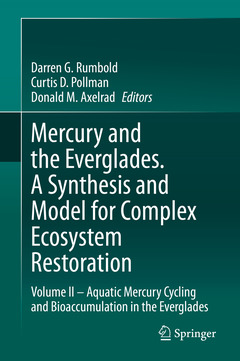Description
Mercury and the Everglades. A Synthesis and Model for Complex Ecosystem Restoration, 1st ed. 2019
Volume II – Aquatic Mercury Cycling and Bioaccumulation in the Everglades
Coordinators: Rumbold Darren G., Pollman Curtis D., Axelrad Donald M.
Language: English
Subjects for Mercury and the Everglades. A Synthesis and Model for...:
Publication date: 01-2021
273 p. · 15.5x23.5 cm · Paperback
Publication date: 12-2019
273 p. · 15.5x23.5 cm · Hardback
Description
/li>Contents
/li>Biography
/li>Comment
/li>
Dr. Pollman is currently the CEO of Aqua Lux Lucis, Inc. and adjunct research professor in the Department of Geological Sciences at the University of Florida. He also holds a position as Chief Science Officer for Nclear, Inc., which is a start-up venture seeking to commercialize the applications of a novel synthetic calcium silicate mineral for treating water and wastewater




